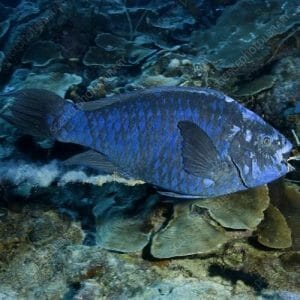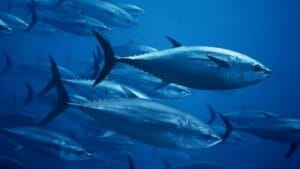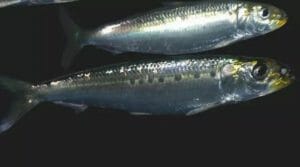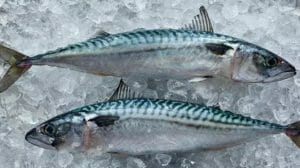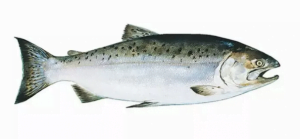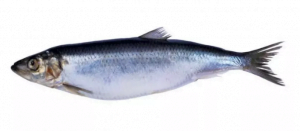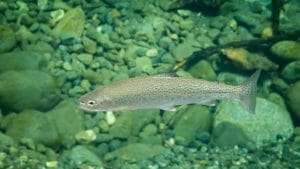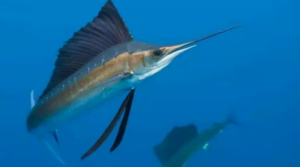Bluefish is only extant species of family Pomatomidae. Blue fish are known as tailor in Australia and New Zealand, Elf and Shad in South Africa. It is a popular game fish and food fish. In this page we discuss about Blue Fish | Learn About Blue Fish and its Types.
Contents
Blue Fish:
The bluefish is only extant species of a family Pomatomidae. It is marine pelagic fish found around world in temperate and subtropical waters except for northern Pacific Ocean. Bluefish are known as tailor in Australia and New Zealand, Elf and Shad in South Africa. The bluefish is moderately proportion fish with broad and fork tail.
The spiny first dorsal fin is normally fold back in groove as its pectoral fins. Coloration is grayish blue green dorsally fading to white on lower sides and belly. Its single row of teeth in each jaw is uniform in size, knife edge and sharp. Bluefish commonly range in size from seven inches “snappers” to much larger. Sometimes weighing as much as 18 kg though fish heavier than 9 kg are exceptional.
Bluefish are widely distribute around world in tropical and subtropical waters. They are found in pelagic waters on much of continental shelves along eastern America, Africa, Mediterranean, Black Seas, Southeast Asia and Australia. They are found in variety of coastal habitats. Above continental shelf in energetic waters near surf beaches or by rock headlands. They also enter estuaries and inhabit brackish waters.
Periodically, they leave coasts and migrate in schools through open waters. Along U.S. East Coast, Blue Fish are found off Florida in winter. By April, they have disappear heading north. By June, they may be found off Massachusetts in years of high abundance stragglers may be found as far north as Nova Scotia.
Blue Fish facts:
- Species name: Pomatomus saltatrix
- Bluefish are distribute: Throughout world’s oceans from tropical to temperate waters. They are common throughout Atlantic Ocean but are also found in Indian and South Pacific Oceans.
- Bluefish are pelagic, schooling fish, staying mainly within the water column. They are voracious predators and can be seen feeding at surface on schools of bait fish.
- Bluefish eat plankton when they are young but transition to a piscivorous diet as they get older.
- Early in life bluefish hunted by larger fish such as:
- Striped bass
- Larger bluefish
- Summer flounder
As adults bluefish are hunted by:
- Tuna
- Sharks
- Bill fish
- Seals
- Dolphins
- Porpoises
- Female Blue Fish lay between 400,000 and 2 million eggs. The eggs are buoyant and drift on currents hatching after approximately 48 hours. They are only 0.08 inches long when hatched. But will start to take on physical characteristics of adult bluefish when they grow to be about half an inch in length.
- Commercial Fisheries usually use gillnets to catch bluefish but sometimes bluefish are caught by hook and line gear or trawls.
- Regulations are create by the Mid-Atlantic Fishery Management Council and the Atlantic States Marine Fisheries Commission. NOAA Fisheries implements these regulations.
Blue fish also known as oily fish. It is one of healthiest foods as its great contribution of omega 3 is one of its greatest benefits and plus for our health. As we have already mention on more than one occasion. In including fish in our diet is essential for good health. It is not surprising that fish is one of essential foods.
Because of many benefits it brings to our body. It is one of most nutritious and healthy foods that exist as fish is one of main sources of polyunsaturated fatty acids. This category most well known are omega 3s, fats that have positive effect on prevention of cardiovascular disease. As they help reduce blood pressure. Also increase good cholesterol and reduce bad cholesterol and triglycerides.
Benefits of blue fish:
Mainly, this type of fish stand out for its great contribution in omega-3 fatty acids. But let’s take closer look at what benefits blue fish brings to our health:
Omega 3, source of health
Blue fish is rich in this type of healthy fat. Being fundamental element to prevent cerebrovascular inconveniences.
Helps lower cholesterol
Blue fish helps us lower bad cholesterol and raise good cholesterol.
Mineral source
Blue fish is great supply of vitamins and minerals such as calcium, iodine, iron, potassium or phosphorus.
High calcium intake
Blue fish also contains fat soluble vitamins that will help preserve strong bones.
Types of Blue Fish:
Before emphasizing different types of blue fish, let’s look at what characteristics divide fish varieties into two groups: blue and white. Although limits are not well define are basically classify base on nutritional criteria.
Specifically, Blue Fish is one that usually comes from deep water. It is characterized by having more lipid content in its meats. Thus, as healthy fats are healthy fats they become an indispensable type of food in any good diet.
On other hand, Blue Fish contains a proportion of intramuscular fat that exceeds 5%. In contrast, white or lean fish contains about only 2%. In addition, there is also an intermediate class and semi-fatty fish. Such as sea bass or gilthead seabream which contain between 2% and about 5% fat.
Within Blue Fish group we can find following varieties, which you can find within section of our products:
- Tuna
- Anchovy or anchovies
- Sardine
- Mackerel
- Nice
- Salmon
- Herring
- Trout
- Eel
- Conger
- Dogfish
- Swordfish
- Turbot
- Horse mackerel
- Thumb
1. Tuna:
A tuna is a saltwater fish that belongs to tribe Thunnini. A subgrouping of Scombridae family. The Thunnini comprise 15 species across five genera sizes of which vary greatly. It ranging from bullet tuna, weight: 1.8 kg up to Atlantic bluefin tuna, weight: 684 kg. The Atlantic bluefin averages 2 m and is believe to live up to 50 years.
Tuna, Opah and mackerel sharks are only species of fish that can maintain body temperature higher than of surrounding water. It is popular as game fish. An active and agile predator, tuna has a sleek, streamlined body and among fastest swimming pelagic fish.
2. Anchovy or Anchovies:
An Anchovy is a small and common forage fish of family Engraulidae. Most species are found in marine waters but several will enter brackish water. Some in South America are restrict to fresh water. The snout is blunt with tiny and sharp teeth in both jaws.
More than 140 species placed in 17 genera. They are found in Atlantic, Indian and Pacific Oceans. They also found in Black Sea and Mediterranean Sea. Anchovies are usually classified as oily fish. Anchovies are small green fish with blue reflections due to silver color longitudinal stripe that runs from base of caudal fin.
3. Sardine:
“Sardine” and “Pilchard” are common names that refer to various small, oily forage fish in herring family Clupeidae. The term “sardine” was first used in English during early 15th century and may come from Mediterranean island of Sardinia around which sardines were once abundant.
The terms “sardine” and “pilchard” are not precise. What is meant depends on region. The United Kingdom’s Sea Fish Industry Authority for example, classifies sardines as young pilchards. One criterion suggests fish shorter in length than 15 cm are sardines and larger fish are pilchards.
4. Mackerel:
Mackerel is a common name applied to number of different species of pelagic fish. Mostly from family Scombridae. They are found in both temperate and tropical seas mostly living along coast or offshore in oceanic environment.
Mackerel species typically have vertical stripes on their backs and deeply forked tails. Many are restrict in their distribution ranges and live in separate populations or fish stocks base on geography. Some stocks migrate in large schools along coast to suitable spawning grounds. Other stocks migrate across oceans.
Smaller mackerel are forage fish for larger predators including larger mackerel and Atlantic cod. Flocks of seabirds, whales, dolphins, sharks and schools of larger fish such as tuna and marlin follow mackerel schools.
5. Salmon:
Salmon is common name for several species of ray finn fish in family Salmonidae. Other fish in same family include trout, char, grayling and whitefish. Salmon are native to tributaries of North Atlantic and Pacific Ocean. Many species of salmon have been introduce into non native environments such as Great Lakes of North America and Patagonia in South America.
Salmon are intensively farm in many parts of world. Typically, salmon are anadromous. They hatch in fresh water, migrate to ocean. Then return to fresh water to reproduce. However, populations of several species are restrict to fresh water throughout their lives. A portion of returning salmon run may stray and spawn in different freshwater systems.
The percent of straying depends on species of salmon. Homing behavior has been shown to depend on olfactory memory. Salmon date back to the Neogene.
6. Herring:
Herring are forage fish. They belonging to family Clupeidae. Herring often move in large schools around fishing banks and near coast. It found particularly in shallow, temperate waters of North Pacific and North Atlantic Oceans. Including Baltic Sea, as well as off west coast of South America. Three species of Clupea are recognize and provide about 90% of all herrings captured in fisheries.
Most abundant of all is Atlantic herring, providing over half of all herring capture. Fishes called herring also found in Arabian Sea, Indian Ocean and Bay of Bengal. Herring played pivotal role in history of marine fisheries in Europe and early in 20th century.
Their study was fundamental to the evolution of fisheries science. These oily fish also have long history as an important food fish and often salted, smoked or pickled.
7. Trout:
Trout is common name for number of species of freshwater fish belonging to genera Oncorhynchus, Salmo and Salvelinus. All of subfamily Salmoninae of family Salmonidae. The word trout is also use as part of name of some non-salmonid fish such as Cynoscion nebulosus. The spotted seatrout or speckled trout.
Trout are closely related to salmon and char. Species termed salmon and char occur in same genera as do fish called trout. Lake trout and most other trout live in freshwater lakes and rivers exclusively. While there are others such as steelhead. A form of coastal rainbow trout that can spend two or three years at sea before returning to fresh water to spawn.
Arctic char and brook trout are part of char family. Trout are an important food source for humans and wildlife including brown bears, birds of prey such as eagles and other animals. They are classified as oily fish.
8. Eel:
An Eel ray-finned fish belonging to order Anguilliformes. Which consists of eight suborders, 19 families, 111 genera and about 800 species. Eels undergo considerable development from early larval stage to eventual adult stage and most are predators.
The term “EEL” is also use for some other eel-shaped fish such as electric eels, spiny eels and deep-sea spiny eels. However, evolved their eel-like shapes independently from true eels.
Eel are other clades. Eels live both in salt water and fresh water.
9. DogFish:
Dogfish, any of several small sharks making up an order of chondrichthyian fishes. They composed of families Centrophoridae, Dalatiidae, Echinorhinidae, Etmopteridae, Oxynotidae, Somniosidae and Squalidae.
The Dogfish, spurdog, mud shark or piked dogfish, one of best known species of Squalidae family of sharks. Which is part of Squaliformes order. While these common names may apply to several species. In North America name is also use for freshwater fish or bowfin.
Squalus acanthias is distinguish by having two spines and lacks an anal fin.
10. Swordfish:
Swordfish also known as BroadBills in some countries. They are large, highly migratory, predatory fish characterized by a long, flat, pointed bill. They are popular sport fish of bill fish category though elusive. Swordfish elongated, round-bodied and lose all teeth and scales by adulthood.
These fish found widely in tropical and temperate parts of Atlantic, Pacific, and Indian Oceans. It can typically be found from near surface to depth of 550 m and exceptionally up to depths of 2,234 m. They commonly reach 3 m in length and maximum reported 4.55 m in length and 650 kg in weight.
They are sole member of their family Xiphiidae.
Life History and Behavior:
The Blue Fish is pelagic fish species that migrates north and south along Atlantic coast. Bluefish found in Rhode Island waters are part of larger population that migrates seasonally from Maine in summer months to Florida in winter. Bluefish frequent Bay in early summer and depart by late November to migrate south.
During its first few years bluefish feeds intensely and grows rapidly. Young bluefish called snappers or skipjacks. It enter Rhode Island waters in June as small as 2 inches in length. It grow up to 10 inches by time they leave in late September. Juvenile bluefish seek protected waters such as estuaries and salt ponds to search for food and protection from predation.
Bluefish have indiscriminate feeding habits and prey upon other fish, squid, crabs, American lobsters, and shrimp. Using slashing attack style, schools of bluefish often kill more prey than they eat. Over 70 species of finfish, including river herring, butterfish, Atlantic silversides and even juvenile bluefish. They have been identify in bluefish stomach contents.
Special Notes
- Blue Fish often feed on large schools of baitfish.
- Fish creating a disturbance known as blitzing in water.
- In an attempt to escape, small fish leap into air while bluefish churn up water with tails and snapping jaws.
- During these feeding frenzies water actually looks like it is boiling.
- The Blue Fish is favorite catch of recreational fishers along Atlantic coast with 80 to 90 percent of catch from recreational industry.
- Bluefish is also an important commercial fish species.
- Fishing for juvenile bluefish is popular sport in Rhode Island during summer and fall.
Conclusion:
The Blue Fish is only extant species of a family Pomatomid. It is marine pelagic fish found around world in temperate and subtropical waters except for northern Pacific Ocean. Blue Fish also known as oily fish. It is one of healthiest foods as its great contribution of omega 3 is one of its greatest benefits and plus for our health. Blue Fish is one that usually comes from deep water.

